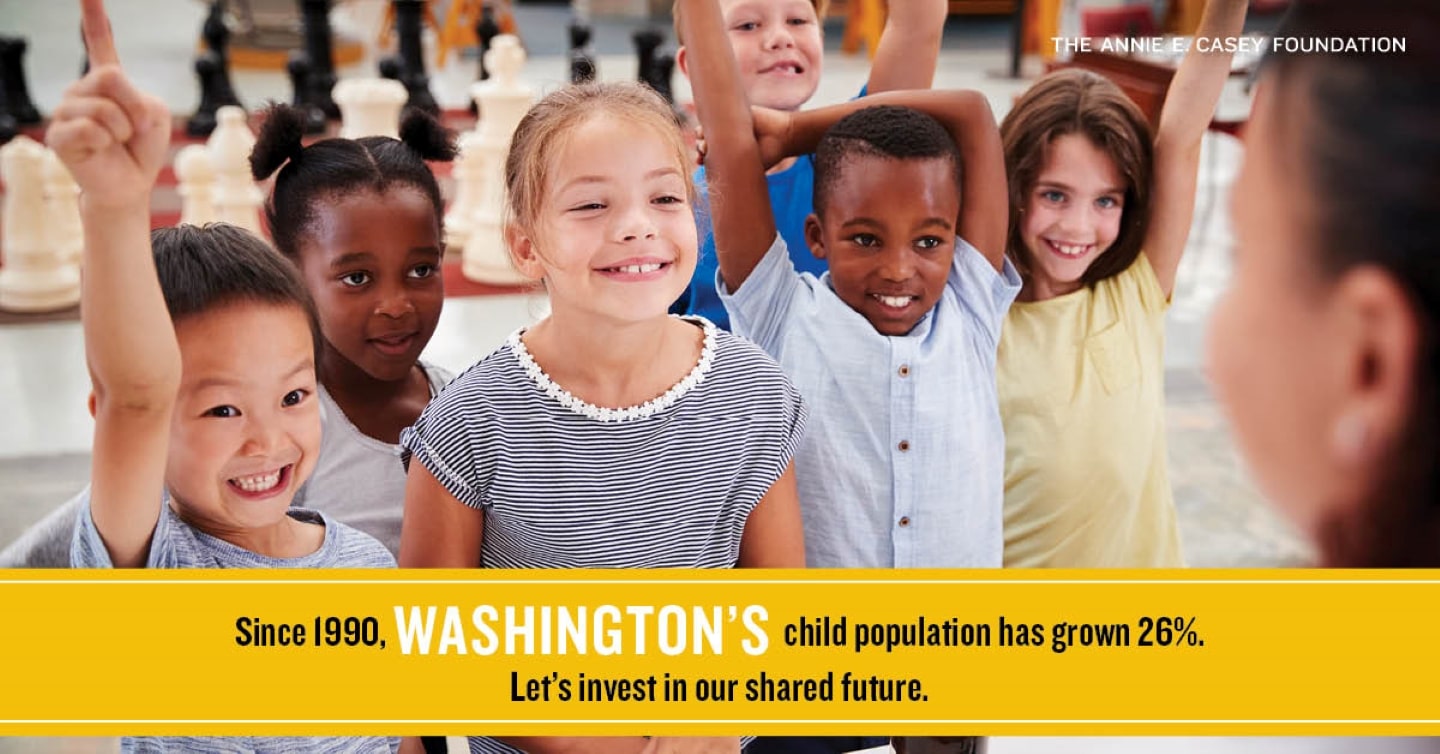Excerpted from the KIDS COUNT in Washington press release
Washington state, one of only 15 states where the growth in the child population has outpaced the national average, is now home to nearly 1.65 million children. While the child population has grown 26% in Washington since 1990 – the year the Annie E. Casey Foundation published its first ever KIDS COUNT Data Book – public efforts to ensure kids’ healthy development have not kept pace.
Critical supports like early learning and health care are proven remedies to poverty and other race-based inequities kids face to a strong, shared future. Yet the 2019 KIDS COUNT Data Book – the most comprehensive annual report on child well-being in the United States – shows that while the percentage of children growing up in poverty has remained relatively stagnant since 1990, the actual number of children in poverty has increased by 36%. And because of an ongoing legacy of racist policies and institutions, child poverty is disproportionately experienced by Washington kids who are Black/African American, Latinx, American Indian or Alaska Native and Pacific Islander or Native Hawaiian. As Washington state grows more diverse, many of these groups of children make up an increasingly large share of our population.
However state investments are not keeping up with the growing number of children in poverty. Washington state lawmakers have a lot of work to do to ensure that every kid in our state has the chance to thrive.

“We can and must do better,” said Paola Maranan, executive director of the Children’s Alliance. “Children are one quarter of our state’s population but 100% of our future. What we do for them today – or fail to do – has long-term implications.”
Among the 50 states overall, Washington state ranks 21st in economic well-being. One in three Washington children live in households that dedicate more than 30%of their income to paying for housing. In addition, the total number of children in Washington state living below the federal poverty line has grown by 36% since 1990.
Yet the state’s approach to the essential basic needs program WorkFirst/Temporary Assistance for Needy Families (TANF) is making it harder for families to get by. Due to sustained budget cuts, WorkFirst/TANF is serving a smaller portion of children in poverty than at any time in the program’s history. And families that are being kicked off the program because of its harsh, inflexible time-limit policy are disproportionately Black and American Indian.
“This disproportionate impact to Black and Indigenous kids is shameful and unacceptable,” says Michelle Merriweather, president and CEO of the Urban League of Metropolitan Seattle. “We need to recognize and act with urgency to make sure public programs are helping build up the next generation — not undercut it before it has a chance to grow.”
In measures of child health, the state has made substantial gains in health-insurance coverage for children in recent years — decreasing the share of uninsured kids by more than half since 2010. Nevertheless, 3% of kids remain uninsured. And each year, half of all kids covered by Apple Health are unable to see a dental professional. Black and Mexican American children with incomes above the federal poverty line have higher rates of untreated tooth decay than white children living below the poverty line.
In early learning, approximately 4 in 10 children in our state ages three and four are attending preschool. While our rates of preschool attendance have grown since 1990, 36 other states have experienced greater increases. Research has shown that investing in high-quality early opportunities like pre-K, quality child care and home visiting can increase the number of kids who are ready for kindergarten, and can reduce racial disparities in readiness for kindergarten.
KIDS COUNT in Washington recommends policymakers take the following steps to ensure our kids are on better track to a healthy, successful life:
- State lawmakers missed an important opportunity this legislative session to make progress toward making sure WorkFirst/TANF is helping more children. During the 2020 session, they must pass legislation to reinvest in this program and roll back harsh time limits and sanctions that have such a negative effect on kids and families — especially Black and American Indian families.
- Washington must continue to work to ensure that no child in the state suffers from preventable health conditions. One promising tool is for state lawmakers to authorize dental therapists to extend care to rural communities, low-income households, communities of color and other populations that lack access to timely, affordable health care.
- Lawmakers need to give more kids high-quality early learning opportunities, like child care and pre-K, to ensure their healthy development.
Read the full 2019 KIDS COUNT Data Book and the KIDS COUNT Washington state 2019 profile.
***
Media Contacts:
Melinda Young-Flynn, melinday@budgetandpolicy.org, (206) 262-0973, x223
Adam Hyla E. Holdorf, adam@childrensalliance.org, (206) 324-0340 x18
About KIDS COUNT in WASHINGTON
KIDS COUNT in Washington is a partnership of the Children’s Alliance and the Washington State Budget & Policy Center, pursuing measurable improvements in child outcomes through equitable public policy measures. The two organizations offer policymakers and the public the knowledge they need to remove the barriers kids face to brighter, freer, more equal futures. For more information, visit www.kidscountwa.org.